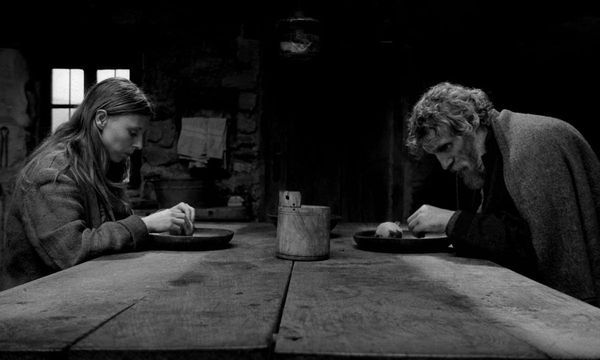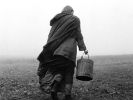Eye For Film >> Movies >> The Turin Horse (2010) Film Review
The Turin Horse
Reviewed by: Chris

How can you make someone see what is staring them in the face?
Tarr's work is nothing if not serious cinema. It may not move, entertain or thrill you to the bottom of your popcorn. But it is, for many cineastes, a standard by which other art cinema can measured. And if that introduction is overweening, perhaps it will deter anyone even vaguely thinking about popcorn - but encourage serious-minded cinema-goers to consider dropping everything to see a screening like this.

In Slow Motion, Jean-Luc Godard demonstrated how, by slowing down a film, we start noticing things that were there anyway - such as the emotions of someone as she walks across a room - that we might not have noticed otherwise. In Dogville, Lars von Trier used Brechtian techniques of characters addressing the audience, and an inescapably obvious bare stage, to make us more aware - perhaps of our own process of watching, analysing. By way of contrast, in action movies, the traditional aim will be to ‘suspend disbelief.’ But how do we ‘suspend belief?’ How do we get closer to the real?
Hungarian Grandmaster Bela Tarr uses a technique made famous by Russian director Andrei Tarkovsky – that of incredibly long takes. We are forced to immerse ourselves in real time, to experience the minutiae of existence (and its totality) in the same way the characters do. But in terms of ‘suspension of beliefs’, Tarr goes one stage further than Tarkovsky. The latter’s films were often connected with metaphysics and decorated with religious iconography; whereas Tarr eschews God and religion in favour of the people, in favour of human rights, in favour of righting wrongs, or simply in favour of what is most basic to any individual. At times seen as heavily political, his films are careful to portray only a ‘documentarist’ style reality. They are films designed to make you think, rather than make you entertained. In this respect, his work preserves a thread from the fierce artistic integrity of Godard - perhaps by way of Fassbinder, who would also at times exemplify a fierce minimalistic style.
In The Turin Horse, Tarr gives us a six-day prelude to an actual event that we never see. Even in those six days, nothing very much happens – yet you could probably write a Masters philosophy dissertation on that ‘nothing very much.’ The ontological lynchpin of the film is Nietzsche: in terms of storyline and also the dilemmas a viewer might confront.
Our movie begins by informing us of a well-known tale concerning the German philosopher. Nietzsche caused a public disturbance – apparently by attempting to save a horse being flogged. Immediately afterwards, Nietzsche collapsed and succumbed to mental illness. He remained that way for the rest of his life.
Tarr’s film is an imagined reconstruction of the days leading up to the incident. It features the ailing horseman, his grown-up daughter, a visitor who provides the film’s only monologue, and a brief visit by a band of gypsies. The horseman and his daughter live in the most spartan of conditions trying to survive, surrounded by a harsh and barren landscape. He probably would have rejected Nietzsche’s philosophy, the rejection (or death) of God, and the idea of the ‘slave-morality’ dominating society. Indeed, the horseman dismisses the reflections of the visitor, whose thoughts are perhaps a shadow of Nietzschean ideas, as “rubbish.” We can perceive a shift from classical belief to atheism as the ideas move quite politically: ‘man is responsible for his own fate, but there is something greater that takes a hand’ - yet that ‘something’ might be nature, rather than ‘God’ and it seems undeniably demonstrated in the harsh conditions that gradually drive the horseman and his daughter nearer extinction. Or it could, of course, be ‘the ruling classes.’
But this is not a film where intellectual arguments are expounded or debated. Most of the dialogue, in the rare instances where dialogue occurs, comprises an occasional monosyllable. The film is in black and white, and consists of just 30 long takes – that would be excruciating were they not mesmerisingly beautiful. Each shot is perfectly composed, right down to the individual hairs on the horseman’s Rasputinish beard. (This is one reason why it could not work as well on a small screen – the other being that its impact depends on having a captive audience.) As in The Man From London, Tarr uses environments as main ‘characters’ – the buildings, the landscape. This not only creates a tremendous sense of grandeur and majesty through simple images, but allows Tarr to convey a cosmic point, even with a miniscule budget. The characters each form a microcosm, doing what they do (what Man does) in order to survive. We are aware of the oppression and hardship of the plebiscite. Dirge-like music, a daily meal of boiled potatoes eaten without cutlery, and a bleakness from which there is no apparent escape.
On the Second Day, the horse, once hitched, won’t move. The daughter expresses some sympathy for its abject refusal. Yet the horse’s gradual deterioration (to a point where it is starving itself to death) almost mirrors the plight of its owners. The horseman and daughter struggle against becoming dehumanised: he by fighting, she by gentleness. What does it mean to be human? As the wind whips dust across the landscape, she reads of the “holy places violated.” To what extent is humanity, and human kindness (of the sort presumably extolled by Nietzsche in trying to save the horse), a luxury for those not reduced to an animal existence by environment and circumstance? One could also argue that it would have been ‘more efficient’ to show the horse some love and tenderness (to treat it not just as a means to an end) – it might then have been more willing to cooperate.
The downside of The Turin Horse is that, given its minority-appeal audience, most people will only see it on DVD. Also, the political landscape about which Tarr is so passionate demands extra study in order to be illuminated by the film. Nietzsche declared that art is the proper task of life, that it is not merely an imitation of the reality of nature, but a metaphysical supplement to nature’s reality. But can The Turin Horse stand philosophically on its own merits? Some may feel that Tarr has indeed flogged his point to death, that he fails to offer any man or super-man to triumph at the end of his inevitable Gotterdammerung.
Constant use of steadicam gives the impression that we are personally observing what happens - even when all motion stops and the last light is extinguished. Susan Sontag once championed Tarr as a saviour of the modern cinema. If she had lived to see this, probably his last film, she surely would probably have felt doubly justified.
Reviewed on: 24 Jun 2011


















